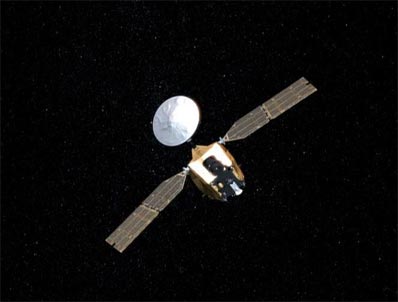
Spaceflight Now +

|

|

|

|

Premium video content for our Spaceflight Now Plus subscribers.

Pluto New Horizons
 Check out NASA's Pluto-bound New Horizons spacecraft undergoing thermal blanket installation inside the cleanroom at Kennedy Space Center's Payload Hazardous Servicing Facility in preparation for launch in January from the Cape. Check out NASA's Pluto-bound New Horizons spacecraft undergoing thermal blanket installation inside the cleanroom at Kennedy Space Center's Payload Hazardous Servicing Facility in preparation for launch in January from the Cape.

 Play video Play video

Mountains of creation
 A new image from NASA's Spitzer Space Telescope reveals billowing mountains of dust ablaze with the fires of stellar youth. The majestic infrared view from Spitzer resembles the iconic "Pillars of Creation" picture taken of the Eagle Nebula in visible light by NASA's Hubble Space Telescope. A new image from NASA's Spitzer Space Telescope reveals billowing mountains of dust ablaze with the fires of stellar youth. The majestic infrared view from Spitzer resembles the iconic "Pillars of Creation" picture taken of the Eagle Nebula in visible light by NASA's Hubble Space Telescope.

 Play video Play video

Space history: STS-51A
 This week marks the anniversary of arguably the most daring and complex space shuttle mission. The astronauts successfully launched two satellites and then recovered two others during extraordinary spacewalks by astronauts using jet-propelled backpacks and pure muscle power. This week marks the anniversary of arguably the most daring and complex space shuttle mission. The astronauts successfully launched two satellites and then recovered two others during extraordinary spacewalks by astronauts using jet-propelled backpacks and pure muscle power.

 Play video Play video

Space station EVA
 Commander Bill McArthur and flight engineer Valery Tokarev conduct a 5 1/2-hour spacewalk outside the International Space Station, installing a TV camera, doing repair chores and jettisoning a failed science probe. Commander Bill McArthur and flight engineer Valery Tokarev conduct a 5 1/2-hour spacewalk outside the International Space Station, installing a TV camera, doing repair chores and jettisoning a failed science probe.

 Play video Play video

The Earth from space
 Return to flight space shuttle commander Eileen Collins narrates an interesting slide show featuring some favorite photographs of Earth taken during her previous shuttle missions. Return to flight space shuttle commander Eileen Collins narrates an interesting slide show featuring some favorite photographs of Earth taken during her previous shuttle missions.

 Play video Play video

Griffin testifies
 NASA Administrator Mike Griffin goes before the U.S. House of Representative's Science Committee to provide an update on the moon-Mars exploration program, the future of the space shuttle and space station, possible servicing of Hubble, cost overruns on the James Webb Space Telescope and the agency's aeronautics research. NASA Administrator Mike Griffin goes before the U.S. House of Representative's Science Committee to provide an update on the moon-Mars exploration program, the future of the space shuttle and space station, possible servicing of Hubble, cost overruns on the James Webb Space Telescope and the agency's aeronautics research.

 Play video Play video

 Become a subscriber Become a subscriber
 More video More video

|

|

|

|
|

|

Mars-bound craft tweaks course, passes halfway point
NASA/JPL NEWS RELEASE
Posted: November 18, 2005
NASA's Mars Reconnaissance Orbiter successfully fired six engines for about 20 seconds today to adjust its flight path in advance of its March 10, 2006, arrival at the red planet.

An artist's concept shows Mars Reconnaissance Orbiter cruising to Mars. Credit: NASA/JPL
|
Since its Aug. 12 launch, the multipurpose spacecraft has covered about 60 percent of the distance for its trip from Earth to Mars. It will fly about 40-million kilometers (25-million miles) farther before it enters orbit around Mars. It will spend half a year gradually adjusting the shape of its orbit, then begin its science phase. During that phase, it will return more data about Mars than all previous missions combined. The spacecraft has already set a record transmission rate for an interplanetary mission, successfully returning data at 6 megabits per second, fast enough to fill a CD-ROM every 16 minutes.
"Today's maneuver mainly increases the speed to bring us to the target point at just the right moment," said Tung-hanYou, chief of the Mars Reconnaissance Orbiter navigation team at NASA's Jet Propulsion Laboratory, Pasadena, Calif. The intended nudge in velocity is 75 centimeters per second (less than 2 miles per hour). The spacecraft's speed relative to the sun is about 27 kilometers per second (61,000 miles per hour).
Four opportunities for course adjustments were planned into the schedule before launch. Today's, the second, used only the trajectory-correction engines. Each engine produces about 18 newtons (4 pounds) of thrust. The first course adjustment, on Aug. 27, doubled as a test of the six main engines, which produce nearly eight times as much thrust. Those main engines will have the big job of slowing the spacecraft enough to be captured into orbit when it reaches Mars. The next scheduled trajectory adjustment, on Feb. 1, 2006, and another one 10 days before arrival will be used, if necessary, for fine tuning, said JPL's Allen Halsell, the mission's deputy navigation chief.
The Mars Reconnaissance Orbiter mission will examine Mars in unprecedented detail from low orbit. Its instrument payload will study water distribution -- including ice, vapor or liquid -- as well as geologic features and minerals. The orbiter will also support future missions to Mars by examining potential landing sites and by providing a high-data-rate relay for communications back to Earth.
The mission is managed by JPL, a division of the California Institute of Technology, Pasadena, for the NASA Science Mission Directorate. Lockheed Martin Space Systems, Denver, is the prime contractor for the project and built the spacecraft.
|

|

|

|


|



